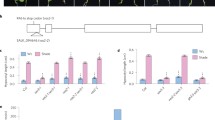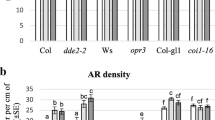Summary
The opening of the hypocotyl hook in bean seedlings is due to a rapid elongation of cells on the inner side of the hook elbow. Red light promotes hook opening by inducing this cell elongation.
Opening is inhibited by low concentrations of indoleacetic acid (IAA) and 2,4-dichlorophenoxyacetic acid (2,4-D), and higher concentrations of these auxins cause a closure of the hook. In darkness, opening is induced slightly by p-chlorophenoxyisobutyric acid (PCIB), whereas in red light this auxin antagonist promotes opening only when IAA is added simultaneously to inhibit opening.
The amount of diffusible auxin released by the hook tissue is not affected by red illumination that is sufficient to induce maximal hook opening.
Gibberellic acid (GA) promotes the hook opening. The magnitude of its effect is, however, rather small, especially in darkness. (2-Chloroethyl)-trimethylammonium chloride (CCC) and 2′-isopropyl-4′-(trimethylammonium-chloride)-5′-methylphenyl piperidine-1-carboxylate (Amo-1618) inhibit hook opening in red light, and this inhibition is completely overcome by addition of GA.
Cytokinins and abscisic acid at rather high concentrations inhibit hook opening in light but produce no significant effect in darkness.
Hook opening is promoted by Ca++ and K+, and notably by Co++ and Ni++.
It is concluded that 1. endogenous gibberellin assists in hook opening, but light does not act by changing the gibberellin level; 2. light does not act by decreasing the endogenous auxin level; and 3. cytokinins or abscisic acid do not seem to have a special role in the response.
Similar content being viewed by others
References
Brauner, L.: Versuche zur Analyse, der geotropischen Perzeption. V. Über den Einfluß des Schwerefeldes auf die Auxinempfindlichkeit von Helianthus-Hypokotylen. Planta (Berl.) 69, 299–318 (1966).
Dennis, D. T., C. D. Upper, and C. A. West: An enzymic site of inhibition of gibberellin biosynthesis by Amo 1618 and other plant growth retardants. Plant Physiol. 40, 948–952 (1965).
Fletcher, R. A., and S. Zalik: Effect of light quality on growth and free indoleacetic acid content in Phaseolus vulgaris. Plant Physiol. 39, 328–331 (1964).
Gillespie, B., and K. V. Thimann: Transport and distribution of auxin during tropic response. I. The lateral migration of auxin in geotropism., Plant Physiol. 38, 214–225 (1963).
Harada, H., and A. Lang: Effect of some (2-chloroethyl) trimethylammonium chloride analogs and other growth retardants on gibberellin biosynthesis in Fusarium moniliforme. Plant Physiol. 40, 176–183 (1965).
Kang, B. G., and P. M. Ray: Ethylene and carbon dioxide as mediators in the response of the bean hypocotyl hook to light and auxins. Planta (Berl.) 87, 206–216 (1969a).
——: Effects of inhibitors of RNA and protein synthesis on bean hypocotyl hook opening and their implications regarding phytochrome action. Planta (Berl.) 87, 217–226 (1969b).
Klein, R. M.: Photomorphogenesis of the bean plumular hook. Physiol. Plantarum 18, 1026–1033 (1965).
Klein, W. H.: Interaction of growth factors with photoprocess in seedling growth. In: Photoperiodism and related phenomena in plants and animals (R. B. Withrow, ed., p. 207–215), Washington, D.C.: AAAS 1959.
— R. B. Withrow, and V. B. Elstad: Response of the hypocotyl hook of bean seedlings to radiant energy and other factors. Plant Physiol. 31, 289–294 (1956).
Nakamura, T., and N. Takahashi: The role of auxin in growth of the plumular hook section of etiolated pea seedling. Plant and Cell Physiol. 9, 681–688 (1968).
—, T. Yamada, and N. Takahashi: Effect of gibberellic acid on growth of the plumular hook section of etiolated pea seedling. Bot. Mag. (Tokyo) 79, 404–413 (1966).
Pickard, B. G., and K. V. Thimann: Transport and distribution of auxin during tropic response. II. The lateral migration of auxin in phototropism of coleoptiles. Plant Physiol. 39, 341–350 (1964).
Steeves, T. A., G. Morel, and R. H. Wetmore: A technique for preventing inactivation at the cut surface in auxin diffusion studies. Amer. J. Bot. 40, 534–538 (1953).
Thimann, K. V., R. R. Slater, and G. S. Christiansen: The metabolism of stem tissue during growth and its inhibition. IV. Growth inhibition without enzyme poisoning. Arch. Biochem. 28, 130–137 (1950).
Went, F. W., and K. V. Thimann: Phytohormones. New York: The Macmillan Co. 1937.
Withrow, R. B., W. H. Klein, and V. Elstad: Action spectra of photomorphogenic induction and its photoinactivation. Plant Physiol. 32, 453–462 (1957).
—, and L. Price: A darkroom safelight for research in plant photobiology. Plant Physiol. 32, 244–248 (1957).
Author information
Authors and Affiliations
Rights and permissions
About this article
Cite this article
Kang, B.G., Ray, P.M. Role of growth regulators in the bean hypocotyl hook opening response. Planta 87, 193–205 (1969). https://doi.org/10.1007/BF00389364
Received:
Issue Date:
DOI: https://doi.org/10.1007/BF00389364




